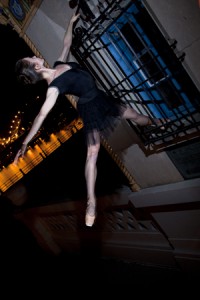by Emily Kate Long
In narrative ballets, choreography exists to say something. There comes a point in the rehearsal process where it feels ineffective to think in terms of steps or counts. Knowing the what and when of the choreography is just the beginning! When the mechanical information—let’s call it the “rags”—begins to feel stale or imposed, it becomes necessary to work from the inside out. Each role, no matter how small, contains vast riches for the performer and audience. To realize them, the artists has to address the how and why of the movement.
Choreography is informed by a character’s self-perception, personality traits, general life attitudes, and relationship to the environment. These things govern a character’s interactions and reactions. When deciding what intent to use for movements, I ask myself some questions:
For internal motivation, is this a positive or negative emotion?
For external motivation, is this a positive or negative reaction/relationship?
What does my body naturally do when I feel hope? Disappointment? Frustration? Relief? Subtle changes in posture, stance, or carriage can drastically change the meaning of choreography. I have to be in tune with myself and the character to make sure my own body language in a given moment is not accidentally polluting my character’s actions.
Is this a question or statement?
To me, questions sound open at the end, and statements sound closed. So, when movements ask something, I let the shapes stay open a little longer or take some time to develop at the end, the same way the last syllables of questions are often slower, longer, or higher in tone. When movements say something strong, they get done and stay shut for emphasis. Neutral statements have a more balanced phrasing.
How can I use stage location or facing to inform the movement?
Real life doesn’t have a proscenium arch. Forgetting where the audience is can help choreography feel more meaningful to my character. One technique I use to trick myself is to imagine that the stage is round and the backdrop is a hemisphere. This works really well for outdoor settings. Indoors, I have two strategies. One is to imagine that the room my character occupies is a different size or shape than the stage. The other is to pretend that the four walls of my character’s space don’t run along the four sides of the stage.
What information is in the music?
Does this music even belong to my character’s story?
Whose music is it? Not everyone onstage has the same story, but usually the music highlights one story at a time for the audience. This is an enormous difference from the type of dancing I grew up with—Balanchine-influenced abstractions and classical divertissements. In those types of works, the entire stage is governed by and responsive to the same music throughout.
Learning to ignore the music is so hard! Finding a word or phrase to cue movements is something I find helpful. It works well when the syllables and intonation of my imaginary words complement the natural rhythm of the steps. That verbal cue can also help override the knee-jerk reaction to dance to the music that I, the dancer, hear, a situation that’s problematic if that music isn’t part of my character’s story.
Cinderella’s triumph as a character—rising above an unfortunate situation—wouldn’t mean much if she didn’t face challenges. She has to start somewhere to get somewhere. Similarly, every new role and every new ballet has to start somewhere. A choreographer’s mental images, video of past productions, notation, and dancers’ muscle memory are all ragged sources on their own. Each is valuable, and each is also fallible, fluid, and subjective. Ragged, raw information is valuable as a departure point. It’s up to all parties involved in to mine the initial information for veins of ore. Only then can creators, performers, and audience all enjoy the riches of our art form. Only then can we grow and triumph.

Assistant Editor Emily Kate Long began her dance education in South Bend, Indiana, with Kimmary Williams and Jacob Rice, and graduated in 2007 from Pittsburgh Ballet Theatre School’s Schenley Program. She has spent summers studying at Ballet Chicago, Pittsburgh Youth Ballet, Pittsburgh Ballet Theatre School, Miami City Ballet, and Saratoga Summer Dance Intensive/Vail Valley Dance Intensive, where she served as Program Assistant. Ms Long attended Milwaukee Ballet School’s Summer Intensive on scholarship before being invited to join Milwaukee Ballet II in 2007.
Ms Long has been a member of Ballet Quad Cities since 2009. She has danced featured roles in Deanna Carter’s Ash to Glass and Dracula, participated in the company’s 2010 tour to New York City, and most recently performed principal roles in Courtney Lyon’s Sleeping Beauty, The Nutcracker, and Cinderella. She is also on the faculty of Ballet Quad Cities School of Dance, where she teaches ballet, pointe, and repertoire classes.





